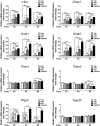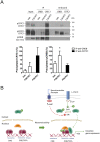CRTC1 mediates preferential transcription at neuronal activity-regulated CRE/TATA promoters
- PMID: 29269871
- PMCID: PMC5740062
- DOI: 10.1038/s41598-017-18215-y
CRTC1 mediates preferential transcription at neuronal activity-regulated CRE/TATA promoters
Abstract
Gene expression mediated by the transcription factor cAMP-responsive element-binding protein (CREB) is essential for a wide range of brain processes. The transcriptional coactivartor CREB-regulated transcription coactivator-1 (CRTC1) is required for efficient induction of CREB target genes during neuronal activity. However, the mechanisms regulating induction of specific CREB/CRTC1-dependent genes during neuronal activity remain largely unclear. Here, we investigated the molecular mechanisms regulating activity-dependent gene transcription upon activation of the CREB/CRTC1 signaling pathway in neurons. Depolarization and cAMP signals induce preferential transcription of activity-dependent genes containing promoters with proximal CRE/TATA sequences, such as c-fos, Dusp1, Nr4a1, Nr4a2 and Ptgs2, but not genes with proximal CRE/TATA-less promoters (e.g. Nr4a3, Presenilin-1 and Presenilin-2). Notably, biochemical and chromatin immunoprecipitation analyses reveal constitutive binding of CREB to target gene promoters in the absence of neuronal activity, whereas recruitment of CRTC1 to proximal CRE/TATA promoters depends on neuronal activity. Neuronal activity induces rapid CRTC1 dephosphorylation, nuclear translocation and binding to endogenous CREB. These results indicate that neuronal activity induces a preferential binding of CRTC1 to the transcriptional complex in CRE/TATA-containing promoters to engage activity-dependent transcription in neurons.
Conflict of interest statement
The authors declare that they have no competing interests.
Figures






Similar articles
-
CRTC1 Function During Memory Encoding Is Disrupted in Neurodegeneration.Biol Psychiatry. 2017 Jan 15;81(2):111-123. doi: 10.1016/j.biopsych.2016.06.025. Epub 2016 Jul 11. Biol Psychiatry. 2017. PMID: 27587263
-
beta-Amyloid disrupts activity-dependent gene transcription required for memory through the CREB coactivator CRTC1.J Neurosci. 2010 Jul 14;30(28):9402-10. doi: 10.1523/JNEUROSCI.2154-10.2010. J Neurosci. 2010. PMID: 20631169 Free PMC article.
-
Region-specific activation of CRTC1-CREB signaling mediates long-term fear memory.Neuron. 2014 Oct 1;84(1):92-106. doi: 10.1016/j.neuron.2014.08.049. Neuron. 2014. PMID: 25277455
-
Regulation of somatostatin gene transcription by cyclic adenosine monophosphate.Metabolism. 1996 Aug;45(8 Suppl 1):4-7. doi: 10.1016/s0026-0495(96)90068-2. Metabolism. 1996. PMID: 8769368 Review.
-
The Pleiotropic Face of CREB Family Transcription Factors.Mol Cells. 2023 Jul 31;46(7):399-413. doi: 10.14348/molcells.2023.2193. Epub 2023 Apr 4. Mol Cells. 2023. PMID: 37013623 Free PMC article. Review.
Cited by
-
Involvement of 5-HT-BDNF signaling axis in mediating synergistic antidepressant-like effects after combined administration of two oligosaccharide esters.Food Sci Nutr. 2021 Jan 4;9(2):1180-1191. doi: 10.1002/fsn3.2098. eCollection 2021 Feb. Food Sci Nutr. 2021. PMID: 33598202 Free PMC article.
-
Regulation of genes involved in the metabolic adaptation of murine microglial cells in response to elevated HIF-1α mediated activation.Immunogenetics. 2024 Apr;76(2):93-108. doi: 10.1007/s00251-024-01334-y. Epub 2024 Feb 8. Immunogenetics. 2024. PMID: 38326657
-
PTPN2 copper-sensing relays copper level fluctuations into EGFR/CREB activation and associated CTR1 transcriptional repression.Nat Commun. 2024 Aug 13;15(1):6947. doi: 10.1038/s41467-024-50524-5. Nat Commun. 2024. PMID: 39138174 Free PMC article.
-
New Insights Into the Pivotal Role of CREB-Regulated Transcription Coactivator 1 in Depression and Comorbid Obesity.Front Mol Neurosci. 2022 Feb 15;15:810641. doi: 10.3389/fnmol.2022.810641. eCollection 2022. Front Mol Neurosci. 2022. PMID: 35242012 Free PMC article. Review.
-
CREB Family Transcription Factors Are Major Mediators of BDNF Transcriptional Autoregulation in Cortical Neurons.J Neurosci. 2020 Feb 12;40(7):1405-1426. doi: 10.1523/JNEUROSCI.0367-19.2019. Epub 2020 Jan 8. J Neurosci. 2020. PMID: 31915257 Free PMC article.
References
-
- Sheng, M., McFadden, G. & Greenberg, M. E. Membrane depolarization and calcium induce c-fos transcription via phosphorylation of transcription factor CREB. Neuron4, 571–582, 0896-6273(90)90115-V (1990). - PubMed
Publication types
MeSH terms
Substances
Grants and funding
LinkOut - more resources
Full Text Sources
Other Literature Sources
Research Materials
Miscellaneous

